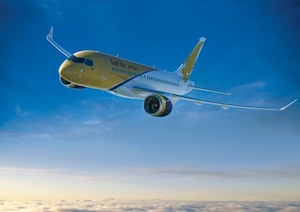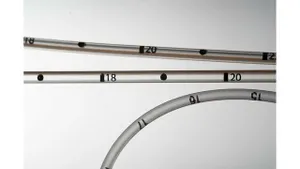Do free trade agreements really create a level playing field?
The short answer is no, because what we really want is fair trade, and that's complicated.
July 17, 2017

As we wait to see what will happen with the renegotiation of the North American Free Trade Agreement (NAFTA), there is always the question of what free trade agreements (FTAs) between countries really mean and whom they benefit: The United States—the market where every country wants to sell its goods—or smaller countries with fewer resources to buy what U.S. manufacturers have to sell?
|
Boeing claims that unfair subsidies have allowed Canada's Bombardier to predatorily price its aircraft in the U.S. market. A C Series aircraft from Bombardier is pictured. |
The Trans-Pacific Partnership (TPP) was one of those questionable free trade agreements that didn’t make sense to me. When I looked at the 11 countries involved in this FTA, I noted in a blog post in October 2015 that it might open Japan’s doors to U.S. imports, but that, given Japan’s reluctance to import U.S. goods, the TPP probably wouldn’t benefit the United States. Australia and New Zealand are good trading partners, too. The rest of those small countries listed in the TPP didn’t appear to offer much in the way of resources to buy many U.S. manufactured goods. The TPP was pretty much a loser for the United States and pulling out of it was a no brainer.
People like to talk about FTAs as deals that will level the global playing field. But free trade agreements always cost something. When looked at closely, will free trade agreements really create a level playing field? Ian Fletcher, author of the book, Free Trade Doesn’t Work, published in 2010, said that while policy makers claim all they want is a “level playing field” and believe that free trade agreements are key to achieving that, they are mistaken. What they want, said Fletcher, is “fair trade,” and he goes on to explain what that looks like. “A true level playing field would require not just equal rules for international trade, but also that nations have the same domestic economic policies, as these can also confer an export advantage,” writes Fletcher. “There are literally thousands of places in an economy where export subsidies can be hidden, from the depreciation schedules of the tax code to state ownership of supplier industries, land use planning, credit card laws, non-performing loans, cheap infrastructure and tax rebates.”
While we read a lot about the automotive industry in Mexico, the aerospace industry has built a manufacturing hub there, as well. When Canadian aircraft producer Bombardier opened an assembly plant at the Queretaro Aerospace Park in Mexico in 2007, it helped put the aerospace industry on the map in that country. According to MexicoNOW, Mexico’s aeronautics parts and components manufacturing industry grew at a healthy pace in recent years. “For the last 10 years, this sector in Mexico has managed to average about 15% annual growth in exports to reach $6.7 billion in 2015,” said the publication. Mexico’s aerospace industry exported $7.6 billion in 2016, 90% of that to the United States.
Trade issues loom large between the three countries. Bombardier “has a long history of relying on government subsidies to compete” with U.S. behemoth Boeing, and these two companies could benefit from an update of NAFTA to help sort out their differences. According to the Information Technology & Innovation Foundation, in a June 12 letter to the Chair of the Trade Policy Staff Committee at the Office of the U.S. Trade Representative, “the subsidies Bombardier received for its C Series aircraft (100- to 150-seat large civil aircraft) were the latest to date and have allowed it to predatorily price its aircraft, thereby displacing potential sales of U.S.-made aircraft around the world.”
The U.S. Department of Commerce initiated an anti-dumping and countervailing duty investigation against Bombardier after receiving a petition from Boeing in May 2017. Boeing argues that “unfair subsidies have allowed Bombardier to predatorily price its aircraft in the U.S. market to the detriment of U.S. companies.” The selling of aircraft below cost is “particularly harmful for an innovative and capital-intensive sector such as aircraft manufacturing, as R&D costs are very high and pricing is set at the time of order, which can be years before the plane is produced.”
Recommendations for a revised NAFTA include getting Canada to permanently withdraw trade-distorting subsidies to Bombardier and to get Bombardier to price its plane at actual market rates.
Boeing had a similar problem with Europe’s Airbus. Boeing has been in a trade dispute with Airbus for more than a decade, with each side accusing the other of accepting billions of dollars in illegal government subsidies and tax exemptions.
Fletcher writes in his book, “Foreign governments often face strong domestic political pressures to keep such subsidies in place, even when they want to strike a deal with the U.S. to eliminate them. . . . But there are thousands of [subsidies] ranging from the Import-Export Bank (cheap loans for exporters) to the Hoover Dam (cheap electricity). And that’s just on the federal level; states and localities constantly bid subsidies against each other to attract businesses. Every tax credit, from R&D and worker training on down, subsidizes something, and if that something is exported, it constitutes an export subsidy.”
Trade agreements don’t always do what people expect them to do and it’s doubtful that many of these deals truly create a level playing field. As Fletcher concludes, “. . . a true level playing field is impossible. And if a level playing field is impossible, then no free-market solution will ever balance trade, and balanced trade will have to be some kind of managed trade.”
About the Author(s)
You May Also Like





